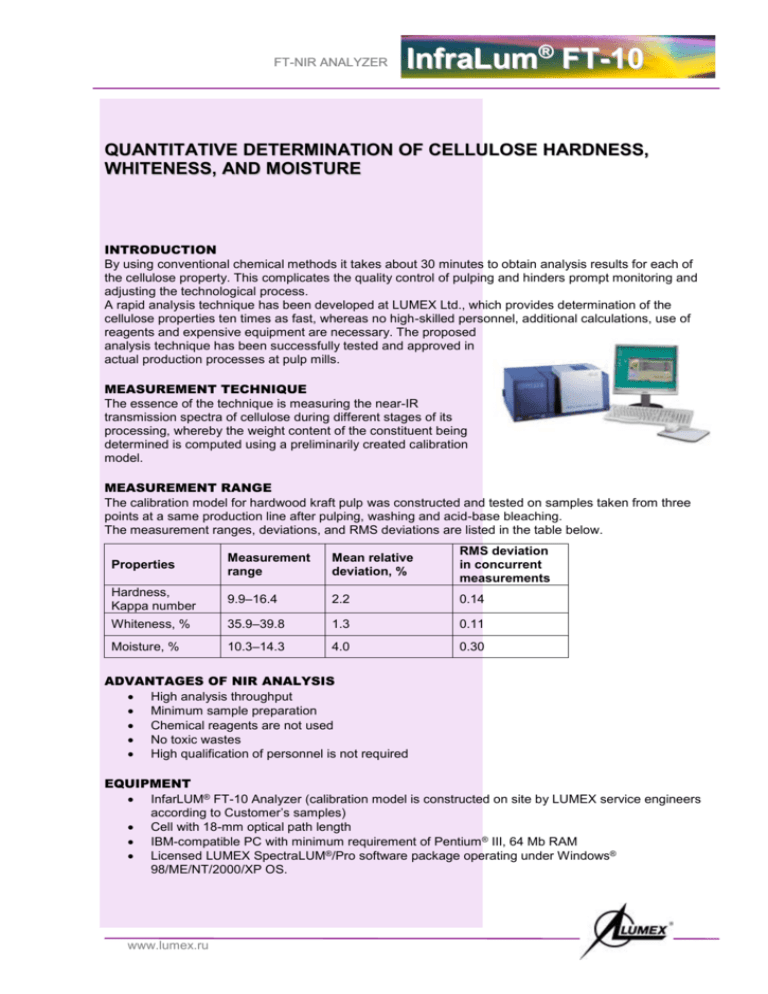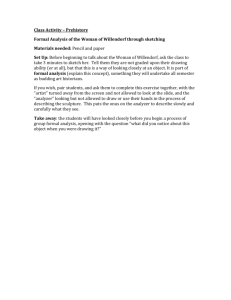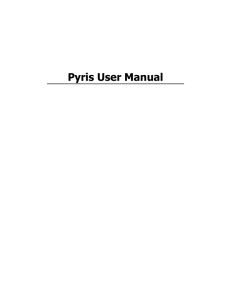Quantitative determination of cellulose hardness
advertisement

FT-NIR ANALYZER InfraLum® FT-10 QUANTITATIVE DETERMINATION OF CELLULOSE HARDNESS, WHITENESS, AND MOISTURE INTRODUCTION By using conventional chemical methods it takes about 30 minutes to obtain analysis results for each of the cellulose property. This complicates the quality control of pulping and hinders prompt monitoring and adjusting the technological process. A rapid analysis technique has been developed at LUMEX Ltd., which provides determination of the cellulose properties ten times as fast, whereas no high-skilled personnel, additional calculations, use of reagents and expensive equipment are necessary. The proposed analysis technique has been successfully tested and approved in actual production processes at pulp mills. MEASUREMENT TECHNIQUE The essence of the technique is measuring the near-IR transmission spectra of cellulose during different stages of its processing, whereby the weight content of the constituent being determined is computed using a preliminarily created calibration model. MEASUREMENT RANGE The calibration model for hardwood kraft pulp was constructed and tested on samples taken from three points at a same production line after pulping, washing and acid-base bleaching. The measurement ranges, deviations, and RMS deviations are listed in the table below. Properties Measurement range Mean relative deviation, % RMS deviation in concurrent measurements Hardness, Kappa number 9.9–16.4 2.2 0.14 Whiteness, % 35.9–39.8 1.3 0.11 Moisture, % 10.3–14.3 4.0 0.30 ADVANTAGES OF NIR ANALYSIS High analysis throughput Minimum sample preparation Chemical reagents are not used No toxic wastes High qualification of personnel is not required EQUIPMENT InfarLUM® FT-10 Analyzer (calibration model is constructed on site by LUMEX service engineers according to Customer’s samples) Cell with 18-mm optical path length IBM-compatible PC with minimum requirement of Pentium ® III, 64 Mb RAM Licensed LUMEX SpectraLUM®/Pro software package operating under Windows® 98/ME/NT/2000/XP OS. www.lumex.ru FT-NIR ANALYZER InfraLum® FT-10 PRE-OPERATIONAL PROCEDURES The following procedures should be performed before starting measurements: sampling, preparation of the analyzer for operation, and calibration of the analyzer. Sampling and preparation of the calibration samples Such samples are used that are commonly analyzed in a laboratory for quality control of the product at a production line. The values of the analyzed properties of the samples should cover the whole working measurement range. Calibration of the analyzer The calibration involves the following stages: Analyzing the samples by standard chemical methods Recording transmission spectra of the samples Constructing a calibration model that interrelates the quantitative content of a constituent in question to the spectral data The working range of the calibration model directly depends on the range of the constituent values, and the error in the constituent determination depends on the accuracy of the analyses of the samples by standard methods. MEASURING PROCEDURE The cell should be filled with a cellulose sample to be analyzed and placed into the InfraLUM® FT-10 analyzer. PROCESSING THE MEASUREMENT RESULTS The measurements and displaying the results on the monitor screen are performed automatically by SpectraLUM ®/Pro Software. It takes three minutes to analyze a sample. An example of a cellulose spectrum recorded at different sampling points in a technological process line. The contents on this paper are subject to change without notice. www.lumex.ru







